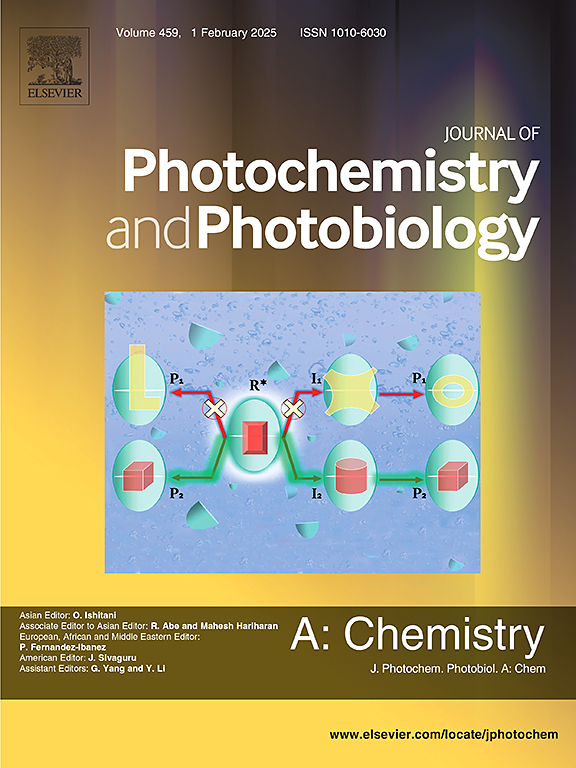用于NADH再生和有机转化的多壁碳纳米管-酸性品红的设计
IF 4.1
3区 化学
Q2 CHEMISTRY, PHYSICAL
Journal of Photochemistry and Photobiology A-chemistry
Pub Date : 2025-05-23
DOI:10.1016/j.jphotochem.2025.116517
引用次数: 0
摘要
制备多壁碳纳米管(MWCNT)-酸性品红复合材料是在太阳照射下同时进行烟酰胺腺嘌呤二核苷酸(NADH)再生和有机转化的一种非常有效的太阳能光催化剂。MWCNTs与酸性品红(一种增感染料,可将半导体材料的光吸收范围增加到可见光谱,从而提高其光催化活性)精心结合。目前的工作需要很容易地合成mwcnt -酸性品红复合材料,并使用FTIR, UV-vis光谱和EIS技术对其进行彻底的表征。为了阐明复合材料在太阳光下作为有效光催化剂的潜力,对其光学和催化能力进行了详细的研究。光催化测试强调了复合材料利用太阳能进行NADH再生和几种有机反应的潜力,这也表明了它们在生物催化和可持续化学方面的适用性。这项研究强调了碳纳米管和有机染料如何协同工作,以增强可再生能源应用中太阳能驱动的光催化作用。本文章由计算机程序翻译,如有差异,请以英文原文为准。

Design of multi-walled carbon nanotube-acid fuchsin for high-performance solar-light photocatalysis in NADH regeneration and organic transformation
A unique strategy for creating extremely effective solar-light photocatalysts for simultaneous nicotinamide adenine dinucleotide (NADH) regeneration and organic conversions under sun irradiation is the fabrication of multiwall carbon nanotube (MWCNT)-acid fuchsin composites. MWCNTs are carefully combined with acid fuchsin, a sensitising dye that can increase semiconductor materials’ light absorption range into the visible spectrum to improve their photocatalytic activity. The present work entails the easy synthesis of MWCNT-acid fuchsin composites and their thorough characterisation using FTIR, UV–vis spectroscopy, and EIS techniques. To clarify the composites’ potential as effective photocatalysts under solar light, a detailed investigation is conducted into their optical, and catalytic capabilities. The composites’ potential to use solar energy for NADH regeneration and several organic reactions is highlighted by photocatalytic tests, which also show how applicable they are to biocatalysis and sustainable chemistry. This study highlights how carbon nanotubes and organic dyes work together to enhance solar-driven photocatalysis for use in renewable energy applications.
求助全文
通过发布文献求助,成功后即可免费获取论文全文。
去求助
来源期刊
CiteScore
7.90
自引率
7.00%
发文量
580
审稿时长
48 days
期刊介绍:
JPPA publishes the results of fundamental studies on all aspects of chemical phenomena induced by interactions between light and molecules/matter of all kinds.
All systems capable of being described at the molecular or integrated multimolecular level are appropriate for the journal. This includes all molecular chemical species as well as biomolecular, supramolecular, polymer and other macromolecular systems, as well as solid state photochemistry. In addition, the journal publishes studies of semiconductor and other photoactive organic and inorganic materials, photocatalysis (organic, inorganic, supramolecular and superconductor).
The scope includes condensed and gas phase photochemistry, as well as synchrotron radiation chemistry. A broad range of processes and techniques in photochemistry are covered such as light induced energy, electron and proton transfer; nonlinear photochemical behavior; mechanistic investigation of photochemical reactions and identification of the products of photochemical reactions; quantum yield determinations and measurements of rate constants for primary and secondary photochemical processes; steady-state and time-resolved emission, ultrafast spectroscopic methods, single molecule spectroscopy, time resolved X-ray diffraction, luminescence microscopy, and scattering spectroscopy applied to photochemistry. Papers in emerging and applied areas such as luminescent sensors, electroluminescence, solar energy conversion, atmospheric photochemistry, environmental remediation, and related photocatalytic chemistry are also welcome.

 求助内容:
求助内容: 应助结果提醒方式:
应助结果提醒方式:


